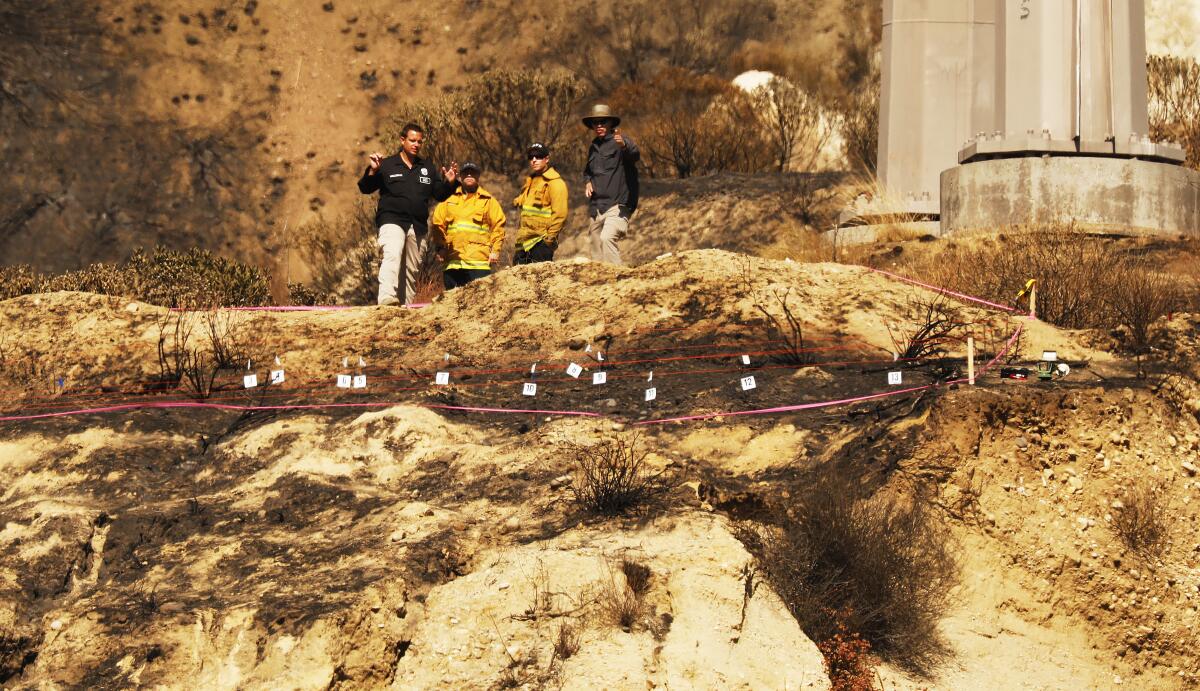Should Edison have shut off more power before Saddleridge fire? California blackout debate rages

- Share via
The conditions seemed right last week for Southern California Edison to power off the towering electric lines that sweep behind a row of stucco homes in the Sylmar foothills. Winds were high, humidity was low, and there was plenty of dry fuel to ignite if a Santa Ana gust caused a spark to fly or a transformer to blow.
But Edison did not power down the transmission lines, even though the utility cut electricity to other areas during those days of high, hot winds. Some nearby residents are now questioning that decision, especially with the news Monday that the 8,000-acre fire, which destroyed 17 structures and damaged 58, started beneath an Edison high-voltage transmission tower.
Edison this week repeatedly declined to answer questions on its decision-making before the fire, whose cause remains undetermined, according to fire investigators.
Edison revealed to regulators its equipment in the area was “impacted” about the time the fire began, but hasn’t offered further details. It also declined to comment on a state map that shows that the risk of a utility-sparked fire in that area is considered “extreme,” and National Weather Service data Oct. 10 showed wind gusts exceeded 30 mph in the area throughout the day and night.
The lack of clarity is renewing calls for more transparency from utility officials as they make decisions that could affect millions of Californians.
State Sen. Henry Stern (D-Canoga Park), whose district includes the area where the Saddleridge fire began, said utilities face a “complex tension” in which they get criticized if they are overly aggressive in shutting down power or take a risk in keeping the lights on.
“Our Monday morning quarterback says, ‘We should’ve shut down that line.’ But when we shut it down you’re mad,” Stern said. “You can’t democratize decision-making ... but we do have the right to know how they’re making that decision.”
California utilities are woefully behind on maintenance and new power systems to prevent long-term blackouts.
The focus on Sylmar comes after Gov. Gavin Newsom, state regulators and consumer advocates have lambasted Pacific Gas & Electric for its widespread power outages of last week, which many called excessive. PG&E shut down power to millions of customers, while Edison cut electricity to far fewer, 24,000, drawing less attention to the utility, except now, with the Saddleridge fire.
As of Friday morning, the fire had burned 8,391 acres and was 68% contained.

Edison has prepared a Wildfire Mitigation Plan, in which it explains to regulators and the public some of its criteria for ordering “public safety power shutoffs.” These shutoffs, the plan says, would be done only “when conditions pose a significant threat to the public.”
It also acknowledged “refining the tactical and strategic decision making protocols” around the shutoffs.
“The complexities of the service territory, including size, topography, wind and weather patterns, and the uncertainty of weather events, make it difficult to predict exact locations where proactive de-energization would or should be consistently considered,” the Wildfire Mitigation Plan says.
When asked about why the lines above Sylmar remained energized, Edison spokesman David Eisenhauer referred back to the utility’s boilerplate criteria for outages: high winds, low humidity, vegetation moisture, on-the-ground observations, potential threats to infrastructure and public safety risk.
Shutoff decisions are made by an “incident management team” of Edison executives, meteorologists and others. The Edison plan lists 14 bullet points to be considered each time the utility preemptively cuts power. The criteria include the potential impacts to customers and communities, red-flag warnings issued by the National Weather Service and alternatives for rerouting power around affected areas.
Over time, utility officials say, public safety power shutdowns will affect smaller groups of customers as equipment is added to the grid to better fragment them. Stern and others have called for developing a micro-grid, in which rural or vulnerable communities can live off their own power supplies for days at a time. Experts say a combination of approaches — burying power lines in some areas, insulating them in others, replacing wood poles with sturdier ones — can collectively lead to a more hardened, reliable grid.
But in the meantime, the focus remains on the companies to provide more answers. On Thursday, the leader of the state Senate called for an investigation into how PG&E reached its power shutdown decision that affected more than 2 million customers. The utility’s chief executive said in a news conference last week that the company would do better in the future.
Daniel Drumlake, who lives just blocks from the Saddleridge fire’s likely ignition point, said he would favor power shutdowns during the windiest and driest days.
“After experiencing a couple of these big ones, sure, they should shut down,” said Drumlake, who teaches culinary arts at Glendale Community College. Still, he acknowledged that people were likely to complain about outages. When his neighbors suggest all the power lines should be undergrounded, he tells them: “You know how many billions, maybe trillions [of dollars] it would cost to bury those lines?”
Donna Porco, a 35-year resident of the Sylmar hillside just below the giant transmission lines, acknowledged that utility officials are “darned if they do and darned if they don’t” — customers will complain about intentional power shutdowns or about fires that come when the lines aren’t shut down. Still, she said, in conditions like the ones last week, when the winds howl down the Newhall pass, the lines should be turned off.
“The easiest thing to do is just turn it off and be inconvenienced for a few days,” said Porco, a retired special education assistant in the Los Angeles schools. “At least then you have a home to go to, and vegetation in the backyard and all the animals survive.”
Madu Shah, an accountant, lives just across the street from a home that burned on Beaufait Avenue in Porter Ranch. Twice over three decades she has seen her neighbors’ homes burn. She was reminded of last year’s Camp fire, the deadly blaze sparked by a PG&E line that devastated the community of Paradise in Northern California.
“If you can save houses and people, of course, shut the power off,” Shah said. “Look at what happened in Paradise. Oh, my God. Anything is better than that.”
More to Read
Sign up for Essential California
The most important California stories and recommendations in your inbox every morning.
You may occasionally receive promotional content from the Los Angeles Times.
















